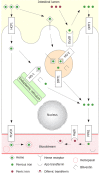Mechanisms of heme iron absorption: current questions and controversies
- PMID: 18636652
- PMCID: PMC2725368
- DOI: 10.3748/wjg.14.4101
Mechanisms of heme iron absorption: current questions and controversies
Abstract
Iron is a critical micronutrient, and iron derived from heme contributes a large proportion of the total iron absorbed in a typical Western diet. Heme iron is absorbed by different mechanisms than non-heme iron, but despite considerable study over many years these mechanisms remain poorly understood. This review provides an overview of the importance of heme iron in the diet and discusses the two prevailing hypotheses of heme absorption; namely receptor mediated endocytosis of heme, and direct transport into the intestinal enterocyte by recently discovered heme transporters. A specific emphasis is placed on the questions surrounding the site of heme catabolism and the identity of the enzyme that performs this task. Additionally, we present the hypothesis that a non-heme iron transport protein may be required for heme iron absorption and discuss the experiences of our laboratory in examining this hypothesis.
Figures


References
-
- Lieu PT, Heiskala M, Peterson PA, Yang Y. The roles of iron in health and disease. Mol Aspects Med. 2001;22:1–87. - PubMed
-
- Assessing the iron status of populations. Report of a Joint World Health Organization/Centers for Disease Control and Prevention Technical Consultation on the Assessment of Iron Status at the Population Level [online], 6-8 April 2004 [cited 14 June 2006], Geneva, Switzerland. Available from URL: http://whqlibdoc.who.int/publications/2004/9241593156_eng.pdf.
-
- Walsh RJ, Kaldor I, Brading I, George EP. The availability of iron in meat: some experiments with radioactive iron. Australas Ann Med. 1955;4:272–276. - PubMed
-
- Narasinga BS. Physiology of iron absorption and supplementation. Br Med Bull. 1981;37:25–30. - PubMed
-
- Bezwoda WR, Bothwell TH, Charlton RW, Torrance JD, MacPhail AP, Derman DP, Mayet F. The relative dietary importance of haem and non-haem iron. S Afr Med J. 1983;64:552–556. - PubMed
Publication types
MeSH terms
Substances
LinkOut - more resources
Full Text Sources
Other Literature Sources
Medical

